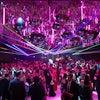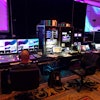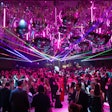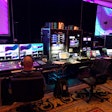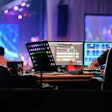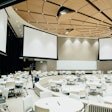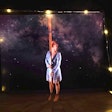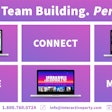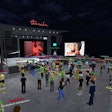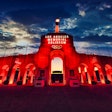
Planners often have to wear many hats, figuring out everything from program content and menus to room layouts and technical production for their events. One of the most daunting tasks can be audiovisual production, which becomes more complex as continual changes create new options and new lingo to understand. We asked four experts in the field of technical production to identify and demystify some of the key concepts to keep in mind.
1. Don’t skimp on audio. One tip shared by all four experts was that quality audio is essential. That means making sure every attendee, whether sitting in the center of the room or in a back corner, can hear the event or meeting’s speakers. Think about both the quality of the audio equipment and the number of microphones. “If there are six speakers in any given section of a program, rent six wireless lavalieres,” Brandt Krueger, the director of video and production technology for Minneapolis-based MetroConnections, says. “Don’t try to get away with two, planning on ‘swapping them out’ between speakers. With every swap, you increase the chances that a speaker will turn off the mic, or a cable will come unplugged.”
2. Make sure the content fits the equipment. Nowadays, most screens are high-definition, wide-screen 16:9 aspect ratio. If presenters have content created in the old 4:3 format, you’ll see black bars along the top and bottom or sides. If you have older graphics or standard-definition videos, ask your production company to reformat them ahead of time. And if you are creating something new, make sure it is formatted correctly.
3. Don’t assume power is included. Find out how much your venue charges for power and how they define it—meaning, do they charge only for large power requests, or for everything down to plugging a cord into a wall?
4. Don’t block projection lines. “Oftentimes there is not sufficient rear-projection distance in a room, and we must front-project onto video screens. It isn’t possible to do this if there is a chandelier or other piece of scenic [equipment] in between the video projectors and the screens,” David Smith, the president of ShowPro in Los Angeles, says.
5. Understand variable items that affect your cost, such as...
Rigging points: The places in the ceiling where you can hang lights, sound equipment, and projectors. Find out if your venue charges for these.
Audio inputs: Count every microphone, as well as each piece of computer audio, video playback, and audience response equipment to ensure your sound mixing board can accommodate all of the inputs.
Display inputs: Like audio mixers, video switchers have a finite number of inputs. Count all of your video sources, including backups, to make sure your budget accounts for the right type of switcher.
Display outputs: If you have multiple screens each showing different images, it will cost more than a single signal on all screens.
6. Get more than one bid for audiovisual services. In-house audiovisual companies are convenient, know the space, and can be flexible since they often keep an inventory on site. If the venue won’t penalize you, though, it’s still a good idea to compare a quote from an outside vendor and possibly use it as a negotiating tool.
7. Focus on the senses. “The color of the lights can create a warm mood, create a cooler mood, wake people up in the morning, calm people down in the evening, and reenergize them after a meal,” Mike Stengel, senior vice president at PSAV, says. Music also affects the mood, so think about what is playing as people enter and exit your event throughout the day. Scent machines can be used to provide an additional sensory experience, but first consider if attendees may have any allergies.
8. Reserve the venue for enough time to account for set up and tear down. Don’t get caught having to pay your crew overtime to set up a show in the middle of the night because you didn’t book the venue the day before. “This can be one of the most expensive ‘gotchas’ out there,” Krueger says.
9. Establish clear content deadlines and formats for your presenters. Ask them to turn in their presentations well in advance, preferably in digital format through a download-sharing program. “If a presenter hands us a thumb drive right before they rehearse, we will spend more time fixing their presentation than we will rehearsing their presentation,” Smith says. “Don’t be afraid to nudge your client to get materials early. They’ll thank you after a perfect show.”
10. Take care of the technical crew. Provide crew members clear information about where to park, where to enter the facility, and when they will get breaks, and provide meals on show day. “If you take care of the crew, they will be sure to take care of you,” Trace Goodman, the president of Goodman Audio Services in Santa Fe Springs, says.
11. Ensure you have appropriate Internet access. In addition to your attendees who will want to use social media, check email, or go online, high-speed Internet access is also used by modern audiovisual equipment to stream audio and video. Use one of the readily available bandwidth calculators to get an idea of what you’ll need, and talk to your venue to determine what it can provide.
12. Hire a technical director. The technical director is the coordinator among all of your vendors, facilitating communication and scheduling so people have what they need when they need it. “Your lighting vendor will not know that your scenic vendor needs to use the only lift available at the exact time he needs to focus his lights. Your technical director will catch that and work it out,” Smith says.
